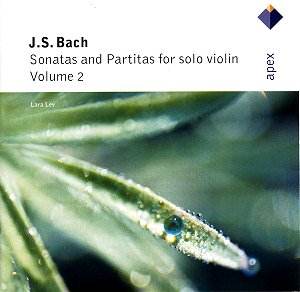Bach's sonatas and partitas for solo violin stand apart in
the composer's work, as well as in the entire repertoire of violin music.
While other composers have written solo pieces for violin (some of Bach's
predecessors, such as Biber, Westhoff and Walther had written solo violin
works, and others wrote solo pieces after Bach), none approach Bach's
works, which stand at the summit of the violin repertoire. Written in
the middle of Bach's life (completed in 1720), these six suites achieve
the unthinkable - they manage to express complex polyphonic music with
an essentially monophonic instrument. When listening to them, one is constantly
amazed at the unheard harmonies that are created in the listener's inner
ear through Bach's magnificently subtle counterpoint.
This disc, the second of two, features the second and
third partitas and the third sonata. The first disc of this set was
disappointing, and there was little reason to expect anything different
from this second disc. This disc opens with the 2nd partita in D minor,
the best-known of the solo violin works because of the famous chaconne
it contains, on of Bach’s most astounding masterpieces. Surprisingly,
Lara Lev is in her element here. Gone are the hacking bow strokes, the
raucous double-stops and the rough sound of the first disc. The gigue
of this partita is even a model of phrasing and energy.
But then we come to the chaconne: the litmus test for
every violinist. The complications here are legion: changing tempi,
difficult arpeggios and double-stops, and a melodic texture that only
the greatest can reproduce. Lev begins this movement with harsh bowing,
attacking the violin with too much force, especially in the arpeggios,
resulting in a hacking sound that is not entirely agreeable. The smoother,
more melodic phrases flow well under her bow, and the flowing section
that begins at around 3:00 is nicely played; Lev manages to maintain
the proper rhythm for the very difficult passages in this section, which
many violinists cannot do. The next section, where the melody is interleaved
with the most complex arpeggios, is brilliantly executed, though her
bowing is a bit rigid, and becomes harsh at the end of this part. The
performance continues in this manner - with ups and downs - through
the end of this movement. And the net result is one of confusion and
contrasts: at times, Lev plays inspired music, with great feeling, but
at others it just sounds all wrong.
And these contrasts continue throughout the remainder
of the recording. There are some fine moments, which stand out all the
more because of the poor playing that comes between them.
As for the first disc of this set, the contrasts are
such that it is just not worth considering this recording. Go instead
for one of the many fine recordings of these great works, such as the
first Sigiswald Kuijken recording on DHM, played on a beautiful baroque
violin, or the legendary recording by Arthur Grumiaux, on Philips.
Kirk McElhearn

